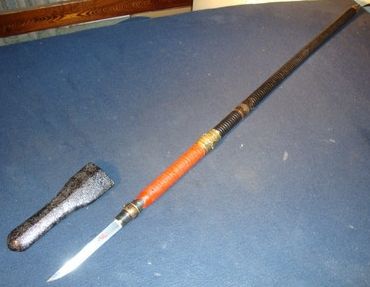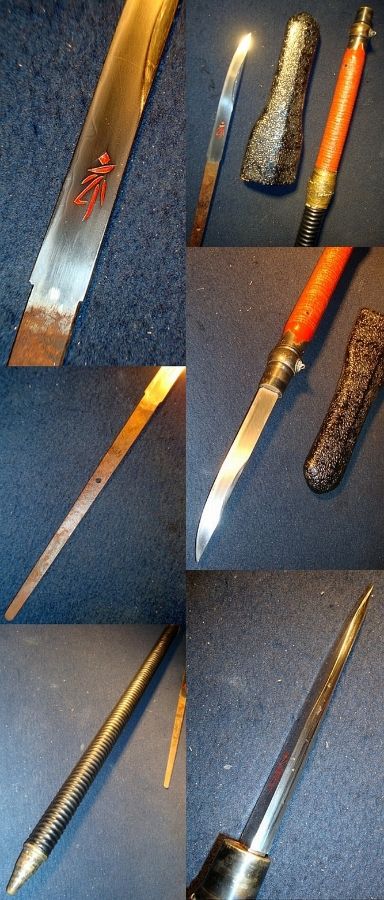|
|
Post by justin520 on Oct 26, 2013 2:42:58 GMT
Has anybody seen these or handled them, what is their standard handle length? I'd like to know because I think a short yari would be cool to own. Also were there short naginata (not nagamaki)?
|
|
|
|
Post by justin520 on Oct 26, 2013 2:45:35 GMT
Also what is standard blade length on these shorties?
|
|
|
|
Post by randomnobody on Oct 26, 2013 9:44:29 GMT
Can't say I've ever heard of a "pillow spear" but that sure sounds interesting.
I've seen a few yari converted to tanto, but that's different to what you're looking for. I can't say I've ever seen anything other than the very typical spear-length stuff, save a few shirasaya mounts.
I'm rather surprised nobody else has chimed in with anything yet...granted, this thread is a whole seven hours old. :oops:
|
|
|
|
Post by justin520 on Oct 26, 2013 13:14:57 GMT
Yeah as I read more I find these obscure weapons with little info on them and I wanna know more.
|
|
|
|
Post by american samurai on Oct 27, 2013 14:28:31 GMT
It is not the length of the blade that makes a te yari, makura yari or kago yari, it is the length of the koshirae. During the Edo period swords became the preferred weapon, old yari were shortened and new ones were made shorter for use in the confined spaces of cities and towns. Yari were used for home protection (makura yari) and te yari are said to have been used by samurai police officers, very short yari (kago yari) were used when traveling by palanquin. Examples of these types of yari are hard to find.  Antique Edo period samurai te yari (hand spear), a short spear for use in confined spaces. The blade is a Sasaho yari meaning the blade portion is leaf shaped or more specifically bamboo leaf shaped, nagasa:11.74cm (4.625"), pole:104.14cm (41"). |
|
|
|
Post by justin520 on Oct 27, 2013 19:03:53 GMT
Are these ever seen with kikuchi blades?
|
|
|
|
Post by randomnobody on Oct 27, 2013 20:49:35 GMT
You won't be seeing much with kikuchi blades. Kikuchi was a rather short-lived, local style, from what I've seen about. I'm eager to be corrected, of course.  |
|
|
|
Post by justin520 on Oct 27, 2013 20:54:15 GMT
I figure if I wanted to I could commission a sino tanto with a looooooong nakago and mount it as a kikuchi te yari. In response to the dude above you though, how long is typical makura yari koshirae? I figure in door use means real short like but specifics help in an anthropologically correct design.
|
|
|
|
Post by randomnobody on Oct 27, 2013 20:56:38 GMT
The one pictured looks to be around the five foot mark, overall? I imagine not much taller than one's shoulder, if that. This would, of course, differ between people, but I imagine something like a 6-8" blade on a 4-foot pole would be close enough to "average" for something like this.
String of guesses and speculation, but what the heck.
|
|
|
|
Post by american samurai on Oct 28, 2013 22:51:06 GMT
The measurements are right under the image, the blade length is 4.6 inches, the pole is 41 inches so all together just under 4 feet. There is no actual exact requirements as to size, its more of an feeling, if a yari was cut down or made much shorter then the usual length it would fall into one of the mentioned categories. from what I have seen a makura yari could be nothing more then a plain pole with a yari blade mounted on it, they did not always have fittings as these were meant for household defense, te yari had all of the usual fittings they were just much smaller then normal yari, kago yari were very small and could have fancy fittings as they were used by higher ranking samurai while traveling.
nagasa:11.74cm (4.625"), pole:104.14cm (41").
|
|
|
|
Post by Jussi Ekholm on Oct 29, 2013 16:07:41 GMT
From Zutetsu Nihonto Yogo Jiten classification of these is "short, straight yari of 3 to 6 sun in length." The book classifies yari as straight blades and blades with side blades. So it does not literally mean straight. And the length is from 9 cm to 18 cm.
What American Samurai is saying about the fittings is similar to the info I have in books.
What Randomnobody said about the kikuchi yari is true, from same book as above "Type of yari used primarily by the Kikuchi Clan in Higo province in the Nanbokucho period."
One friend in our Finnish nihonto group has wide variety of different yari types. He also has a makura yari, I can ask him about it.
|
|
|
|
Post by Gelue on Oct 29, 2013 21:50:04 GMT
|
|
|
|
Post by Novice_Surgery on Oct 29, 2013 23:40:09 GMT
Ooh I want one.
|
|
|
|
Post by american samurai on Oct 29, 2013 23:46:09 GMT
A nice example, I do not think there is a size listed for the length of the pole, here is a better view of it. Muramasa makura yari, tokubetsu hozon by the NBTHK, signature associated with the second generation Muramasa, pole and saya of a small size that would be suitable for indoor fighting (makura-yari), and were often kept by the bedside at night. Muromachi Koto (ca. 1500), nakago:ubu, two mekugiana (both original), mei: Muramasa, nagasa:12.2cm.  |
|
|
|
Post by american samurai on Oct 29, 2013 23:57:39 GMT
Correcting now...kikuchi yari were originally a very old style blade, in later years some were converted into awesome looking yoroi doshi tanto, some were kept as yari and eventually ended up being made into short te / makura type yari. Yari were also made in later times in the kikuchi yari style. Here are a couple of examples. Kikuchi yari, kanmuri-otoshi kikuchi-yari shape with sanskrit engravings, Muromachi period (1550's), made in Kikuchi, Higo province (Kumamoto prefecture), wavy notareba temper with nie (crystal) activity throughout the blade, healthy turn-back temper at the point, itame-hada forging grain. Mounted in makura yari koshirae with urushi lacquered in rokizami finish. 5+5/8" cutting edge, 5/8" width, 8mm thickness at the notch, 37" pole and 45" in mountings.   Kikuchi yari, possibly an Edo period one, mounted as a te / makura yari.  |
|
|
|
Post by american samurai on Oct 30, 2013 0:06:32 GMT
Two more yari with very short poles. Sei sankaku yari (yari blades that have a triangular cross section with three equal sides as in an equilateral triangle).  Ryo shinogi fukuro yari, (diamond shaped cross section, socket yari), size: cutting edge:10cm, total blade:20cm, mounted:127cm.  |
|
|
|
Post by randomnobody on Oct 30, 2013 0:07:26 GMT
I forgot about this thread.
Completely missed the measurements at the bottom in that other post, and am fascinated by the examples in the latest. In all the (very few) places I could find any information on the kikuchi yari, it was constantly repeated that these were exceedingly rare and very localized, hence, named for the province. Haven't looked around for them in ages, though.
It's precisely times like this when I quite like being wrong.
I'm blown away by how narrow that one is, though. 5/8" just strikes me as puny in any package...not that I'd want to be poked with it. :shock:
Whoops, you slipped in another on me. Nice.
Edit: Why do I still try to post from my phone? I think I got everything fixed this time...
|
|
|
|
Post by american samurai on Oct 30, 2013 4:53:17 GMT
5/8 in across the back edge is actually quite thick, kikuchi yari are basically tanto mounted on a pole, you would have to look hard to find a tanto that thick, I have only seen a couple of yoroi doshi that were over a half inch across the back edge. Here is a picture if a yoroi doshi tanto blade showing the motogasane (blade thickness) at the hamachi (the notch at the beginning of the cutting edge) with is .5 inches across.  |
|
|
|
Post by randomnobody on Oct 30, 2013 8:29:13 GMT
You phrased it as a width of 5/8" and a thickness of 8mm, though, which made me think the blade was only 5/8" from cutting edge to spine, or "haba" rather than "kasane" be or moto or saki in either case. 5/8 is pretty thick for any blade, but it's very narrow for a profile size. I have a pocketknife with a blade only 2mm thick in the spine and about 1/2" wide in profile, so I was thinking to compare it to that, which I've always thought very narrow, even for a pocketknife. Especially one just shy of 4" long. I was interpreting your measurements as 5 5/8" long, 5/8" wide, 8mm thick. If it's 5/8 thick, that's another story, and I'll assume the 8mm was something else I'm missing.
|
|
|
|
Post by american samurai on Oct 30, 2013 8:52:00 GMT
Your right, it is 0.314961 at the hamachi....duhh!!! You can see the blade geometry on this image, its wedge shaped.  |
|

